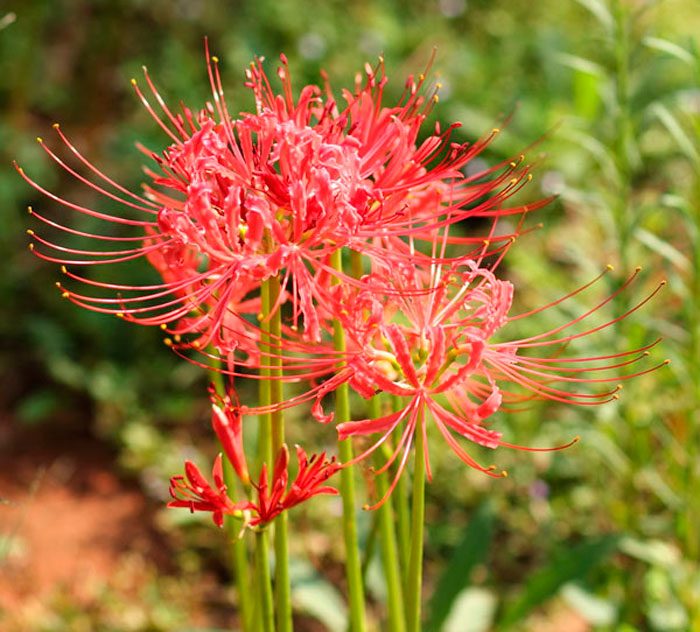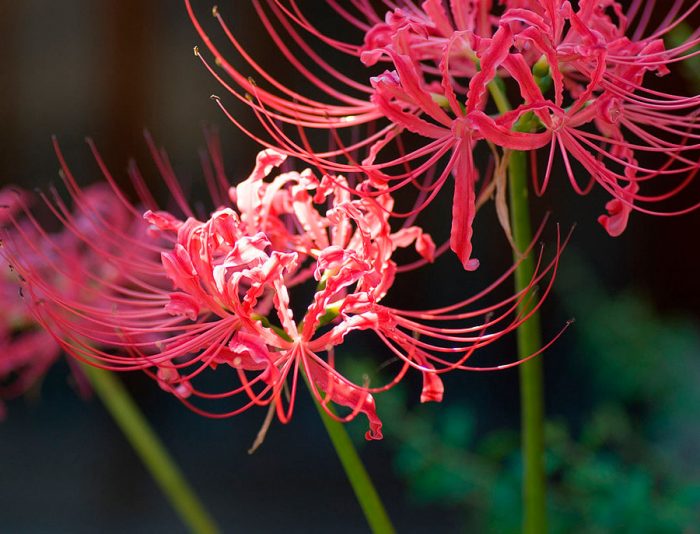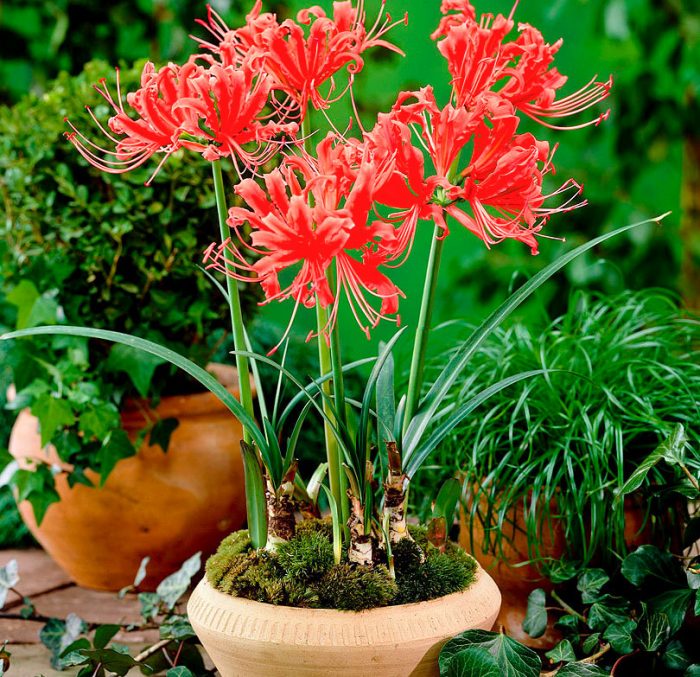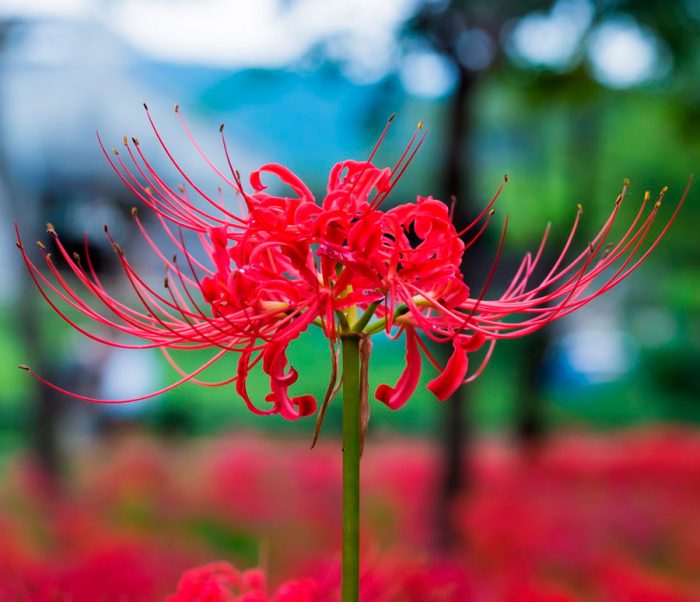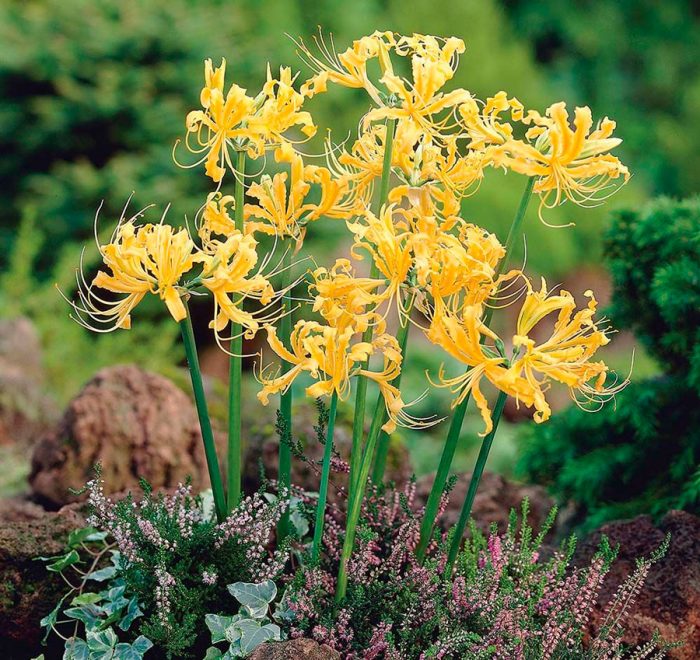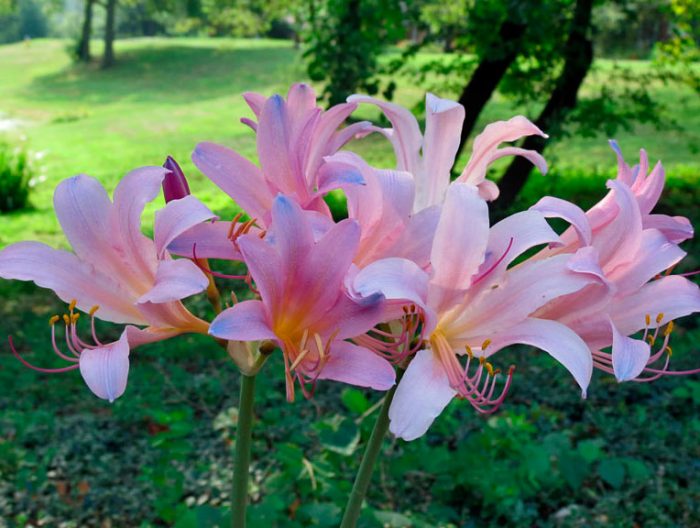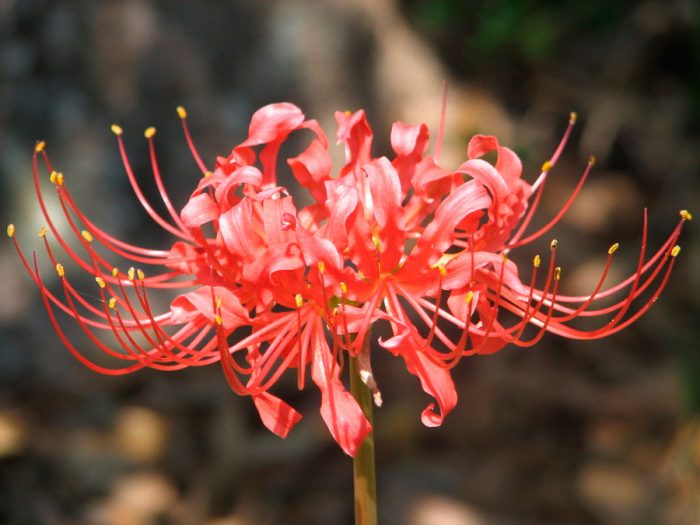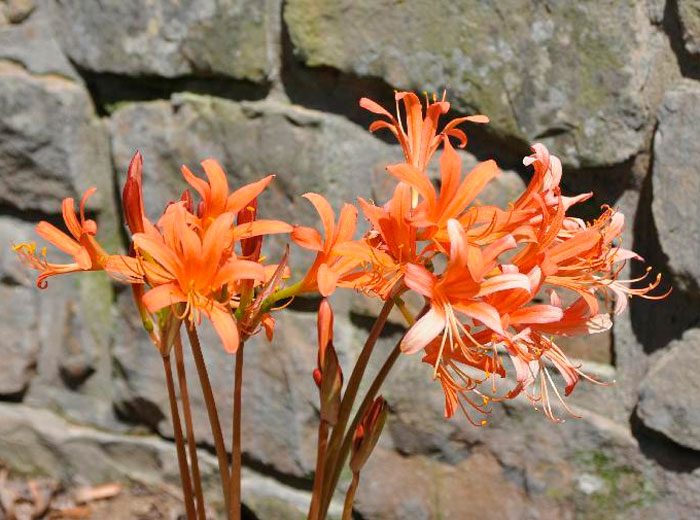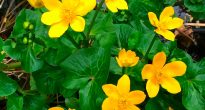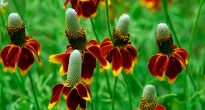A flowering perennial plant, Lycoris, is a member of the Amaryllis family. This genus unites more than 20 species. Such a plant comes from South and East Asia: Thailand, South Korea, Pakistan, southern China, Japan, Laos, Nepal and eastern Iran. Some species of lycoris were brought to North Carolina, Texas and other states of America, some of them naturalized in a new place. In English-speaking countries, such a plant is called "spider lily" or "hurricane lily". In the scientific literature, you can find the Japanese name for lycoris - "higanbana". This culture is also called the "flower of death", the fact is that it is often planted in cemeteries.
Content
Lycoris features
The length of the leaf plates varies from 0.3 to 0.6 m, and their width is about 0.5 to 2 cm.The height of the erect stem varies from 0.3 to 0.9 m.This plant is capable of giving about 7 peduncles, per which are fragrant flowers. They can be orange, golden, white, red, yellow or purple in color. The flowers of such a plant are of two different types:
- stamens several times longer than the perianth;
- stamens only slightly rise above the petals.
The fruit is a three-channel box containing seeds. Most of the lycoris species are sterile, therefore they reproduce only vegetatively.
Such a plant has a biological peculiarity, its leaf plates and flowers do not meet each other. What time does such a culture bloom? In the summer, the bulbs in the ground have a dormant period. Peduncles begin to grow in the first days of September, while they gain height very quickly. So, after 4 or 5 days, the height of the arrows can reach about 0.5 m and even more. On 1 peduncle, 4 or 5 flowers grow, which have an external resemblance to lilies, they have a funnel-shaped shape and many stamens. Due to this, the flowers have an external resemblance to a spider. Duration of flowering is about 15 days, then the wilting of flowers is observed. Only when the plant fades, it begins to form arrow-shaped leaf plates, they do not die throughout the entire winter period, but this happens only in the first summer weeks.
Planting lycoris in the open field
What time to plant
It is recommended to plant lycoris in autumn 4 weeks before frost sets in. During this time, the bulbs will have time to adapt to a new place, and their roots will grow. If there is such a need, the planting of the bulbs can be done in the spring, but it should be noted that in this case there is a high probability that the flowers will be very sore. The flowering of this plant next year after planting almost certainly will not come, the fact is that it is very moody.
It is relatively difficult to grow this culture. To do this, you must carefully choose a site suitable for growing, and the licorice will also need to provide growth conditions that will be very similar to natural ones. The optimal site for growing such a plant is one that is protected from drafts and gusts of wind and is located in the partial shade of large deciduous trees.
Landing rules
This culture grows well on sandy soils. Prepare the site by removing all weeds from it and digging it up, if necessary add sand, peat, and also humus to it. At the end, the surface of the site must be leveled. On the surface of large bulbs are scales of a dark brown color, they must be planted in the soil to a depth of at least 14 centimeters, otherwise they can freeze out in very cold winter. Between the planting pits, a distance of 0.25–0.3 m should be observed, the fact is that every year children appear on the bulbs, and each of them needs a feeding area.
The bottom of the hole needs to be covered with a layer of sand, then a bulb is placed in it and pressed a little into the substrate. After that, the bulb must be covered with pre-prepared sand, and ordinary soil is used to fill the remaining empty space. When the lycoris is planted, the soil in the hole must be tamped, and then the planting is well watered.
Licorice care in the garden
Growing lycoris in your garden is a snap. To do this, he will need to ensure timely watering, weeding, loosening of the soil near the bushes and top dressing. Also, the bushes need preparation for wintering. If necessary, lycoris is transplanted, as well as the destruction of harmful insects.
How to water and feed
Particular attention should be paid to watering lycoris during the intensive growth of leaf plates and peduncles. During this period, the surface of the soil under the plants should be constantly humid, while trying to avoid completely drying out the earth. During the dormant period, which is observed in winter and summer, it is not necessary to water such a culture.
Such a plant does not need mandatory feeding. If the shrub is effective and healthy, it means that it has enough nutrients. However, if the bushes look oppressed or lethargic, then it is recommended to feed them with a special mineral fertilizer for bulbous crops.
Transfer
Unlike most bulbous crops, it is not necessary to replant lycoris every year. It can be grown in the same place for about 5 years, but then the bulbs must be removed from the ground, divided and planted in a new place. First you need to start preparing new landing holes. Then the bulbs must be removed from the soil, the children must be separated, while this must be done carefully, and then the places of the breaks must be treated with wood ash or crushed coal. After that, the bulbs are planted in open soil (the planting procedure is described above). If the lycoris is transplanted in the autumn, then the area is not watered. It should be borne in mind that transplanted plants may not bloom for the first 1-2 years after this procedure. You also need to remember that excessively frequent transplants and division of lycoris bushes lead to their strong weakening. It is necessary to work with such a plant with gloves, since all its parts contain poisonous substances.
How to propagate
Often, daughter bulbs are used to propagate such a culture. The fact is that it is quite difficult to obtain lycoris seeds, all the more so when you consider that some species do not form them at all. It is very simple to propagate such flowers vegetatively, or rather, by daughter bulbs, and how to do this is described above.
After flowering
The formation of leaf blades is observed after the wilting of flowers. In the last autumn weeks, pruning of dried parts of the bush is done. It is not necessary to remove the bulbs from the soil for the winter, since they take deep roots and are not afraid of severe frosts. If the winters in the region have little snow and are very cold, then the surface of the site must be covered with a layer of spruce branches or dried foliage. In spring, the shelter is removed from the site.
Diseases and pests
Licorice is highly resistant to diseases and pests. However, narcissus flies can settle on it, in this regard, for preventive purposes, the site is spilled with an insecticide solution during the intensive growth of the bushes.
Types and varieties of lycoris with photos and names
Gardeners cultivate a relatively small number of lycoris species. The ones that are most popular will be described below.
Golden Lycoris (Lycoris aurea)
The homeland of this species is China and Japan. The plant has low frost resistance, it is not afraid of air temperature drops to minus 5 degrees. In this regard, in middle latitudes, this species is cultivated only at home. The height of the bush is about 0.6 m, and its diameter is about 0.2 m. The rich yellow flowers have a tubular shape, they reach about 10 centimeters in diameter. Their opening is observed in the last spring or first summer weeks. Inflorescences consist of 5 or 6 flowers.
Licoris scaly (Lycoris squamigera)
This species comes from Japan. The height of the bush varies from 0.6 to 0.7 m. Basal leaf plates of a broad-linear belt-like shape grow after the flowers wither. They are collected in a bunch of 6-8 funnel-shaped fragrant flowers of pinkish-lilac color, the central part is yellow, the perianth lobes are bent. The plant does not form seeds; therefore, daughter bulbs are used for its reproduction.
Licoris radiant (Lycoris radiata)
In nature, this species can be found in Korea, Nepal and China, and it is also naturalized in Japan, the United States of America and other countries. In this perennial plant, leaf plates grow later than flowers. Flower arrows have a height of 0.3 to 0.7 m. Leaf plates are placed parallel to each other, their width does not exceed 10 mm, in some cases they bend from the center of the plate. The shape of the flowers is irregular, their lateral petals are similar to the long and thin whiskers deflected back, while in their middle there is a bunch of wide and short petals, the shape of which is wavy and arcuate.
Blood red lycoris (Lycoris sanguinea)
The height of such a compact bush is about 0.45 m. This species forms very small leaves in April, which die in June. Flowering is observed in August. Flowers of deep scarlet color reach 50 mm in diameter.

